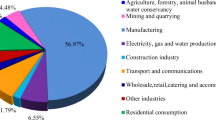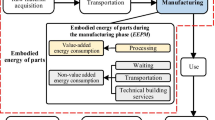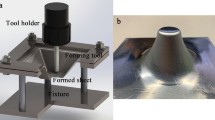Abstract
Nowadays, increased concerns about energy-efficient and environmentally benign manufacturing process have become an emerging issue. Deep drawing is a widely used traditional process especially in the automotive and aeronautical industries, which is also energy intensive and accounts for a large portion of energy consumption in metal forming sectors. The investigation of sheet metal forming energy saving is worth studying and, within this research field, a certain lack of energy prediction models or tools is still present. The aim of this research was to contribute towards the development of analytical models and logic for estimating the energy consumption in sheet metal forming processes, which could provide the basic for a significant energy reduction. An application to a spherical part deep drawing process was used to verify the validity and rationality of the models with the results deviation within 10%. And the effects of the process parameters on energy consumption were discussed. The overall contribution of the main process parameters on energy consumption was analyzed through a matrix of experiments. The obtained results allowed to be used for guiding process optimization of energy saving and the selection of manufacturing parameters.
Similar content being viewed by others
References
BP Statistical Review of World Energy (2016) http://www.bp.com/en/global/corporate/energy-economics/energy-outlook/china-and-its-energy-needs.html. Accessed 15 March 2017
Branker K, Jeswiet J, Kim I (2011) Greenhouse gases emitted in manufacturing a product—a new economic model. CIRP Ann Manuf Technol 60(1):53–56. https://doi.org/10.1016/j.cirp.2011.03.002
Wiki - Wikipedia (2015) https://en.wikipedia.org/wiki/Stamping_(metalworking)
Pell Research (2011) Sheet metal industry statistics report. http://www.pellresearch.com.html
Zhao K, Liu Z, Yu S, Li X, Huang H, Li B (2015) Analytical energy dissipation in large and medium-sized hydraulic press. J Clean Prod 103:908–915. https://doi.org/10.1016/j.jclepro.2014.03.093
Ingarao G, Ambrogio G, Gagliardi F, Di Lorenzo R (2012) A sustainability point of view on sheet metal forming operations: material wasting and energy consumption in incremental forming and stamping processes. J Clean Prod 29-30:255–268. https://doi.org/10.1016/j.jclepro.2012.01.012
Zein H, El Sherbiny M, Abd-Rabou M (2014) Thinning and spring back prediction of sheet metal in the deep drawing process. Mater Des 53(1):797–808. https://doi.org/10.1016/j.matdes.2013.07.078
Padmanabhan R, Oliveira M, Alves J, Menezes L (2007) Influence of process parameters on the deep drawing of stainless steel. Finite Elem Anal Des 43(14):1062–1067. https://doi.org/10.1016/j.finel.2007.06.011
Wang J, Goel A, Yang F, Gau JT (2009) Blank optimization for sheet metal forming using multi-step finite element simulations. Int J Adv Manuf Technol 40(7–8):709–720. https://doi.org/10.1007/s00170-008-1383-y
Gao M, Huang H, Li X, Liu Z (2016) Carbon emission analysis and reduction for stamping process chain. Int J Adv Manuf Technol 91(1–4):667–678. https://doi.org/10.1007/s00170-016-9732-8
Göschel A, Sterzing A, Schönherr J (2014) Balancing procedure for energy and material flows in sheet metal forming. CIRP J Manuf Sci Technol 4(2):170–179. https://doi.org/10.1016/j.cirpj.2011.06.018
Göschel A, Schieck F, Schönherr J (2012) Method for energy and resource balancing demonstrated as an example of the hot sheet metal production process. CIRP Ann Manuf Technol 61(1):399–402. https://doi.org/10.1016/j.cirp.2012.03.005
Li W (2015) Efficiency of manufacturing processes. Spring. https://doi.org/10.1007/978-3-319-17365-8
Kara S, Li W (2011) Unit process energy consumption models for material removal processes. CIRP Ann Manuf Technol 60(1):37–40. https://doi.org/10.1016/j.cirp.2012.03.005
Kishawy H, Kannan S, Balazinski M (2004) An energy based analytical force model for orthogonal cutting of metal matrix composites. CIRP Ann Manuf Technol 53(1):91–94. https://doi.org/10.1016/S0007-8506(07)60652-0
Li W, Kara S (2011) An empirical model for predicting energy consumption of manufacturing processes: a case of turning process. Proc Inst Mech Eng B J Eng Manuf 225(9):1636–1646. https://doi.org/10.1177/2041297511398541
Xie J, Liu F, Qiu H (2016) An integrated model for predicting the specific energy consumption of manufacturing processes. Int J Adv Manuf Technol 85(5–8):1339–1346. https://doi.org/10.1007/s00170-015-8033-y
Mativenga P, Rajemi M (2011) Calculation of optimum cutting parameters based on minimum energy footprint. CIRP Ann Manuf Technol 60(1):149–152. https://doi.org/10.1016/j.cirp.2011.03.088
Rajemi M, Mativenga P, Aramcharoen A (2010) Sustainable machining: selection of optimum turning conditions based on minimum energy considerations. J Clean Prod 18(10):1059–1065. https://doi.org/10.1016/j.jclepro.2010.01.025
Camposeco-Negrete C (2013) Optimization of cutting parameters for minimizing energy consumption in turning of AISI 6061 T6 using Taguchi methodology and ANOVA. J Clean Prod 53(16):195–203. https://doi.org/10.1016/j.jclepro.2013.03.049
Yi Q, Li C, Tang Y, Chen X (2015) Multi-objective parameter optimization of CNC machining for low carbon manufacturing. J Clean Prod 95: 256-264. https://doi.org/10.1016/j.jclepro.2015.02.076
Velchev S, Kolev I, Ivanov K, Gechevski S (2014) Empirical models for specific energy consumption and optimization of cutting parameters for minimizing energy consumption during turning. J Clean Prod 80:139–149. https://doi.org/10.1016/j.jclepro.2014.05.099
Dwivedi R, Agnihotri G (2015) Numerical simulation and experimental analysis on the deep drawing of cylindrical cups. Trans Indian Inst Metals 68(1):31–34. https://doi.org/10.1007/s12666-015-0598-5
Chen J, Zhou X, Chen J (2010) Sheet metal forming limit prediction based on plastic deformation energy. J Mater Process Technol 210(2):315–322. https://doi.org/10.1016/j.jmatprotec.2009.09.017
M.B.СТОРОЖЕВ E. A. П (1980) Principles of metal pressure processing. China Machine Press, Beijing
Parmar A, Mellor P (1978) Predictions of limit strains in sheet metal using a more general yield criterion. Int J Mech Sci 20(6):385–391. https://doi.org/10.1016/0020-7403(78)90041-3
Yu T, Zhang L (1996) Plastic bending: theory and applications, vol 2. World Scientific, Singapore
Lee B, Keum Y, Wagoner R (2002) Modeling of the friction caused by lubrication and surface roughness in sheet metal forming. J Mater Process Technol 130-131(02):60–63. https://doi.org/10.1016/S0924-0136(02)00784-7
Vollertsen F, Hu Z (2006) Tribological size effects in sheet metal forming measured by a strip drawing test. CIRP Ann Manuf Technol 55(1):291–294. https://doi.org/10.1016/S0007-8506(07)60419-3
GB/T228–2010 (2010) In metallic materials-tensile testing-method of test
Phadke MS (1995) Quality engineering using robust design. Prentice Hall PTR, Upper Saddle River
Acknowledgements
This work is financially supported by Funds for International Cooperation and Exchange of the National Natural Science Foundation of China (51561125002), the National Natural Science Foundation of China (51722502), the University Scientific Research key project in Anhui Province of China (KJ2017A438), and the 61st instalment postdoctoral Science Foundation of China (2017M611574).
Author information
Authors and Affiliations
Corresponding author
Rights and permissions
About this article
Cite this article
Gao, M., Huang, H., Wang, Q. et al. Energy consumption analysis on sheet metal forming: focusing on the deep drawing processes. Int J Adv Manuf Technol 96, 3893–3907 (2018). https://doi.org/10.1007/s00170-018-1735-1
Received:
Accepted:
Published:
Issue Date:
DOI: https://doi.org/10.1007/s00170-018-1735-1




